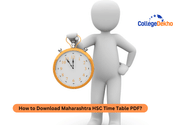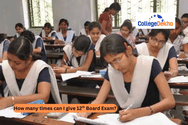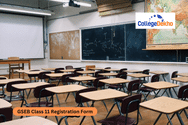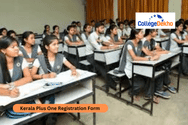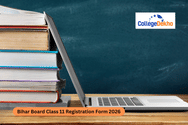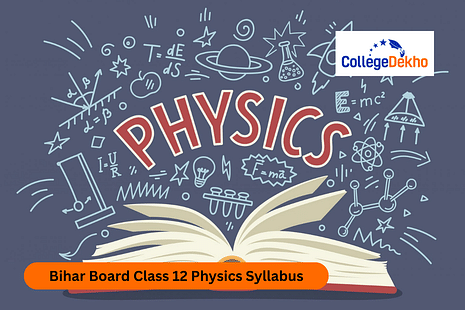

Never Miss an Exam Update
Bihar Board Class 12 Physics Syllabus 2025-26 is framed by the Bihar School Examination Board. The theory paper will be conducted for 70 marks. 30 marks will be provided for the practical exam. The Physics syllabus is divided into 3 units to be studied individually by the students. Students have to score 33% marks in both theory and practical exams to successfully get the passing certificate. Out of the 70 marks allotted for the theory exam, 35 marks will be provided for the objective-type questions, followed by 20 marks for short answer-type questions and 15 marks for long answer-type questions. Internal choices will be included in the question paper provided by the Bihar School Examination Board.
There will be 42 MCQs in the paper, out of which students have to attempt any 35. Students must try to focus on understanding the concepts of all the chapters, which will help them get good marks in the board exams accordingly. Check more information about Bihar Board Class 12 Physics Syllabus 2025-26 here:
Also Read: Bihar Board 12th Physics Previous Year Question Paper
Latest Updates
- December 5, 2025: The Bihar Board Class 12 time table 2026 was released on November 29, 2025, as per which the Class 12 exams will be held from February 2 to February 13, 2026.
Bihar Board Class 12 Physics Syllabus 2025-26
Students can go through the BSEB 12th Physics Syllabus from the tables given below and get the perfect idea regarding the topics that will come in the board exams:
Chapter | Marks Allotted |
|---|---|
Electrostatics | 08 |
Current Electricity | 07 |
Magnetic Effect of Current & Magnetism | 04 |
Magnesium and Matter | 04 |
Electromagnetic Induction | 02 |
| Alternating Current | 04 |
| Electromagnetic Waves | 03 |
Ray Optics | 09 |
| Wave Optics | 05 |
Dual Nature of Matter | 04 |
Atoms & Nuclei | 06 |
Semicounducters | 07 |
Communication System | 07 |
Total | 70 |
Bihar Board Class 12 Physics Syllabus 2025-26 PDF
The BSEB board has made the class 12th Physics syllabus Bihar Board 2025-26 available for students to download and review thoroughly. The Bihar Board class 12th Physics syllabus 2026 is given in the table below, which can be downloaded in PDF format.
| Bihar Board Class 12 Physics Syllabus PDF |
|---|
Bihar Board Class 12 Physics Syllabus- Chapter-Wise Topics
Bihar Board Class 12 Physics Exam Pattern 2025-26 in detail is discussed below.
| Chapter | Topics |
|---|---|
| Chapter 1: Electrostatics |
|
| Chapter 2: Current Electricity |
|
| Chapter 3: Magnetic Effect of Current and Magnetism |
|
| Chapter 4: Electromagnetic Induction and Alternating Current |
|
| Chapter 5: Electromagnetic Waves |
|
| Chapter 6: Optics |
Ray Optics:
|
| Chapter 7: Dual Nature of Matter |
|
| Chapter 8: Atoms and Nuclei |
|
| Chapter 9: Electronic Devices |
|
| Chapter 10: Communication Systems |
|
Also Read: Bihar Board Class 12 Physics Model Paper 2026
Bihar Board Class 12 Practicals 2025-26
Section - A
EXPERIMENTS
- To determine resistance per cm of a given wire by plotting a graph of potential difference versus current.
- To find resistance of a given wire using meter bridge and hence determine the specific resistance of its material.
- To verify the laws of combination (series / parallel) of resistances using a meter bridge.
- To compare the emf's of two given primary cells using potentiometer.
- To determine the internal resistance of given primary cell using potentiometer.
- To determine resistance of a galvanometer by half-deflection method and to find its figure of merit.
- To convert the given galvanometer (of known resistance of figure of merit) into an ammeter and voltmeter of desired range and to verify the same.
- To find the frequency of the AC mains with a sonometer.
ACTIVITIES
- To measure the resistance and impedance of an inductor with or without iron core.
- To measure the resistance, Voltage (AC/DC), current (AC) and check continuity of a given circuit using multimeter.
- To assemble a household circuit comprising .... three (on/off) switches, a fuse and a power source.
- To assemble the components of a given electric circuit.
- To study the variation in potential drop with length of a wire for a steady current.
- To draw the diagram of a given open circuit comprising at least a battery, resistor/rheostat, key, ammeter and voltmeter.
- Mark the components that are not connected in proper order and correct the circuit and also the circuit diagram.
Section - B
EXPERIMENTS- To find the value of v for different values of u in case of concave mirror and to find the focal length.
- To find the focal length of a convex lens by plotting graphs between x and v or between 1/ u & 1/ v .
- To find the focal length of a convex mirror, using a convex lens. To find the focal length of a concave lens, using a convex lens.
- To determine angle of minimum deviation for a given prism by plotting a graph between the angle of incidence and the angle of deviation.
- To determine refractive index of a glass slab using a travelling microscope.
- To find refractive index of a liquid by using (i) concave mirror (ii) convex lens and plane mirror.
- To draw the I-V characteristics curves of a p-n junction in forward bias and reverse bias.
- To draw the characteristic curve of a zener diode and to determine its reverse breakdown voltage.
- To study the characteristics of a common emitter npn or pnp transistor and to find out the values of current of such items.
ACTIVITIES
- To study effect of intensity of light (by varying distance of the source) on an LDR.
- To identify a diode, an LED, a transistor, and IC, a resistor and a capacitor from mixed collection of such items.
- Use of multimeter to –
(ii) Distinguish between npn and pnp type transistors,
(iii) See the unidirectional flow of current in case of a diode and an LED,
(iv) Check whether a given electronic component (e.g., diode, transistor or IC) is in working order.
- To observe refraction and later deviation of a beam of light incident obliquely on a glass slab.
- To observe polarization of light using two polaroids.
- To observe diffraction of light due to a thin slit. To study the nature and size of the image formed by –
(ii) Concave mirror, on a screen by using a candle and a screen (for different distances of the candle from the lens/mirror).
To obtain a lens combination with the specified focal length by using true lenses from the given set of lenses.
Bihar Board 12th Physics Practical Syllabus 2025–26
The Bihar Board 12th Physics syllabus for the academic year 2025–26 includes practical-based learning through experiments, activities, and project work. The syllabus also features a separate list of practical tasks specifically designed for visually impaired students. Key highlights of the practical syllabus are as follows:
- The syllabus is divided into two sections. Students must perform and maintain records for 15 experiments and 5 activities from each section.
- A project report must be prepared based on the practical work conducted during the session.
Bihar Board Class 12 Physics Syllabus 2025-26 will be available on the official website very soon. Don't forget to make a study plan according to the topics included in the syllabus.
Are you feeling lost and unsure about what career path to take after completing 12th standard?
Say goodbye to confusion and hello to a bright future!

FAQs
To revise the BSEB 12th Physics Syllabus 2025-26, focus on completing the sample papers. It is advised to the students to complete at least one sample paper every day for Physics to gain confidence.
Yes, BSEB 12th Physics Syllabus 2025-26 is easy. The chapters coming in the BSB board exams are not very complicated. Students just need to focus on clearing their concepts and they will get good marks accordingly.
The theory paper for the Physics subject will be of 70 marks and 30 marks will be provided for the practical session conducted by the school authority. BSEB 12th Physics Syllabus 2025 PDF will also include the practical syllabus.
No, BSEB 12th Physics Syllabus 2025 is not yet available. Students can get the syllabus by visiting the official website of the Bihar School Examination Board as soon as it is released by the organisation.
Students need six months to complete BSEB 12th Physics Syllabus 2024-25. You must leave at least 2 months for the revision of the preparation that you have done during the previous 6 months.
Bihar School Examination Board will use NCERT textbooks to complete the BSEB 12th Physics Syllabus 2025-26. Students can buy Arihant Publication sample papers in order to do the revision for the board exams.
Bihar Board Class 12 Physics Syllabus 2025-26 is vast because of the many chapters included in the syllabus. Students must focus on one chapter at a time to complete the syllabus at least 2 months prior to the board exams.
No, Bihar Board Class 12 Physics Syllabus 2025-26 is not different from last year. Students can refer to the previous year's syllabus and start their preparation for the board exams till the new syllabus is not released by the organization.
Bihar Board Class 12 Physics Syllabus 2025-26 includes a total of 10 chapters. Electrostatics, current electricity, magnetic effect, Electromagnetic waves, optics, dual nature of matter, electronic devices, and communication systems are some of the topics included in the syllabus.
Bihar Board Class 12 Physics Syllabus 2025-26 will be uploaded on the official website of Bihar School Examination Board under the syllabus option present on the menu bar to be downloaded by the students.
Was this article helpful?










